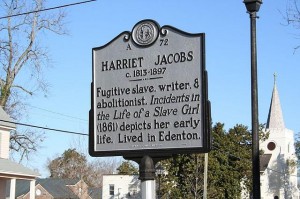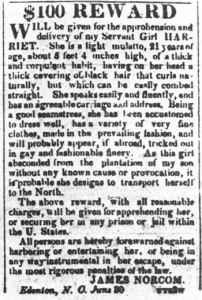Most famous true slave narrative
Posted By Brian Tomlin on October 22, 2012
 Harriet Jacobs was born a slave in North Carolina in 1813. Her mother died when she was six, her father when she was 13. Her mistress/owner taught her to read and write. When the kindly mistress died, Harriet is willed to the woman’s three year old niece, and went to live with a Dr. Norcom who tried to force Jacobs into a sexual relationship. At 29 Jacobs escapes to the North, first to Philadelphia and later to New York and Boston. Jacobs wrote her experiences in a manuscript titled Incidents in the Life of a Slave Girl which was eventually self-published in 1861 after the publisher who initially purchased the book went out of business.
Harriet Jacobs was born a slave in North Carolina in 1813. Her mother died when she was six, her father when she was 13. Her mistress/owner taught her to read and write. When the kindly mistress died, Harriet is willed to the woman’s three year old niece, and went to live with a Dr. Norcom who tried to force Jacobs into a sexual relationship. At 29 Jacobs escapes to the North, first to Philadelphia and later to New York and Boston. Jacobs wrote her experiences in a manuscript titled Incidents in the Life of a Slave Girl which was eventually self-published in 1861 after the publisher who initially purchased the book went out of business.
The work is a tremendous document of the conditions of a female slave, as Jacobs recounts in the section titled “The Trials of Girlhood”:
“But where could I turn to for protection? No matter whether the slave girl be as black as ebony or as fair as her mistress. In either case, there is no shadow of law to protect her from insult, violence, or even from death; all these are inflicted by fiends who bear the shape of men. The mistress, who ought to protect the helpless victim, has no other feelings towards her but those of jealousy and rage. The degradation, the wrongs, the vices, that grow out of slavery are more than I can describe. (pp.27-28).”
The process of how a slave escaped and the fear that followed him or her is another deeply moving part of this work:
“…but until there were miles of water between us and our enemies, we were filled with apprehensions that the constables would come on board. Neither could I feel quite at ease with the captain and his men. I was an entire stranger to that class of people, and I had heard that sailors were rough, and sometimes cruel. We were so completely in their power, that if they were bad men, our situation would be dreadful. Now that the captain was paid for our passage, might he be not tempted to make more money by giving us up to those who claimed us as property? I was naturally of a confiding disposition, but slavery had made me suspicious of every body (p.157).”

A newspaper advertisement placed by Harriet Jacobs owner offering a $100 reward for returning her to him as her property.
Months later Jacobs still feared her master might come to New York and return her to southern slavery.
“It was impossible to tell how near the enemy was. He might have passed and repassed the house while we were sleeping. He might at any moment he waiting to pounce upon me if i ventured out of doors (p.196).”
The work ends with Jacobs and her children as fully free from the threat of slavery, but still without a home of their own. More than any other account of slavery, real or fictitious Harriet Jacobs manages to put a real human face on slavery and the slaves themselves.
The county in North Carolina where Jacobs lived as a slave has created a website to honor her experiences as a slave and runaway on the Underground Railroad.
 ;
;



Comments